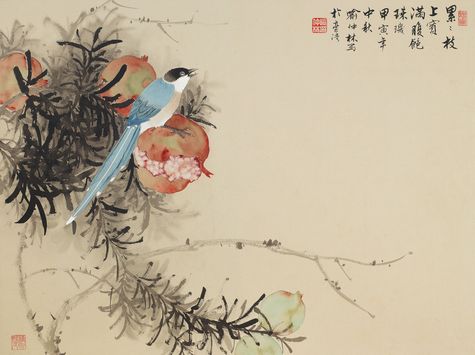

Lot 634
Azure Magpie Feeding on Pomegranate
YU Chung-Lin (Taiwanese, 1925 - 1985)
1974
Ink and colour on paper, framed
47 x 63 cm
Estimate
TWD 190,000-300,000
HKD 49,000-77,000
USD 6,300-10,000
CNY 45,000-71,000
Sold Price
TWD 264,000
HKD 69,291
USD 8,931
CNY 62,559
Signature
With three seals of the artist
+ OVERVIEW
Under the guidance of his master, Yu developed gongbi skills with reference to Song and Yuan style. As a prodigious and diligent artist, he studied traditional paintings closely and was able to paint with the quintessential spirit of Song paintings. His paintings were elegant and refined without being too stiff. He was thus acclaimed as the greatest modern gongbi painter in Taiwan and received the Chinese Literary Award. Three greatest artists of the period Yu Chung-Lin, Hu Nien-Tsu and Sun Jia-Qin, formed an artist group Lishui Jingshe. Each of the artists followed different masters. Yu followed Jin Qin-Bo, Hu followed Huang Chun-Pi and Sun followed Da Feng Tang. The three exchanged art techniques and their joint exhibition received a lot of attention. This was the time when Modern art was thriving in Taiwan, where Chinese paintings were on a decline. The success of Lishui Jingshe allowed gongbi paintings to thrive, and students flooded to take Yu's class.
This work was composed slightly to the left with boneless technique to depict the pomegranates, three on top and two below. Ripen fruits were outlined in red and filled with pink and light green. The seeds were painted in white. Raw ones at the bottom were painted in green with boneless technique. Each detail was meticulously and elegantly painted to demonstrate a luscious scene. The tree was painted with dry ink, leaning to the right. The form of branches created balance in the painting. With water and light ink, the shades of bushes were painted. Leaves and branches were then sketched with thicker ink and broad brush. The movement of brush had high fluidity and force, thus enlivened the work. Magpies were painted in both gongbi and boneless style. Gongbi was used to sketch the beak, eyes and claws. Light ochre was painted on the belly and green was used to depict the wings. Refined brush was used to sketch the feathers which were further accentuated with white tips. The bird stood upright and upheld the spirit of the whole painting. Rested on ripen pomegranate, the magpie was eating the fruit enjoying the season of Autumn. Magpies are unique to Taiwan. Echoing to the abundance of leaves, the plant symbolizes prosperity. The two implications form a message of prosperity and abundance in Taiwan, which was the artist’s wish when it was made in Mid-Autumn Festival.
Refined Brushwork: Fine Chinese Paintings
Ravenel Spring Auction 2020
Saturday, July 18, 2020, 2:00pm
